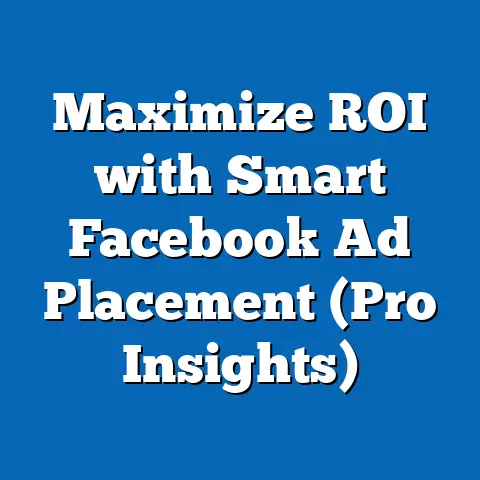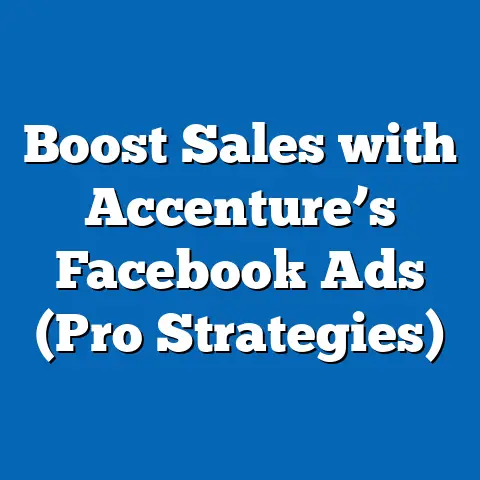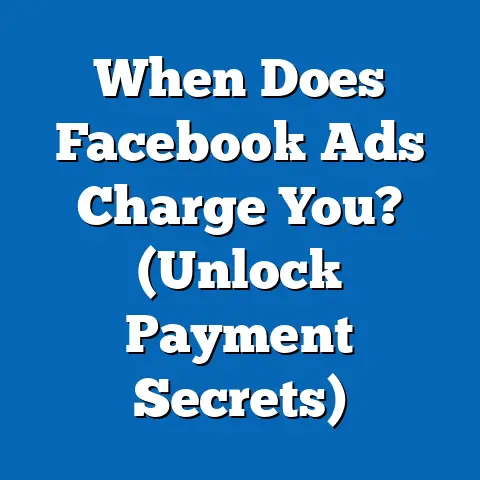Fix Facebook Ad Links (Ultimate Troubleshooting Guide)
In today’s fast-paced digital world, social media and online advertising have become woven into the fabric of our daily lives. Whether we’re connecting with friends, discovering the latest trends, or searching for the perfect product, platforms like Facebook play a central role. For businesses and marketers, Facebook represents a massive opportunity to reach potential customers, drive traffic, and build brand awareness. A well-crafted Facebook ad can be incredibly effective, leading to increased sales and a stronger online presence. But, like any powerful tool, Facebook advertising comes with its own set of challenges. While ad creatives, targeting, and bidding strategies often take center stage, one crucial element can easily be overlooked: the ad link.
Facebook ad links, while seemingly simple, are the bridge between your compelling ad and your desired conversion. They are the pathway that guides users from their newsfeed to your website, app, or event page. However, this pathway can be easily disrupted. Broken links, redirect errors, and incorrect URL parameters can all derail your campaigns, leading to wasted ad spend and missed opportunities. I’ve seen it happen countless times – a perfectly designed ad, meticulously targeted, only to be undermined by a faulty link. It’s like building a beautiful store with no front door!
Understanding Facebook Ad Links
At its core, a Facebook ad link is simply a URL that you include in your Facebook ad to direct users to a specific destination. This destination could be your website, a landing page, an app store listing, an event page, or even a Facebook Messenger conversation. But the power of an ad link lies in its ability to connect your ad with your overall marketing goals.
Different Types of Links in Facebook Ads
Understanding the different types of links you can use in your Facebook ads is crucial for choosing the right option for your campaign objectives. Here’s a breakdown:
- Website Links: These are the most common type of link, directing users to a specific page on your website. This could be your homepage, a product page, a blog post, or a dedicated landing page. I often use these to drive traffic to specific product pages when running e-commerce ads.
- App Links: If you’re promoting a mobile app, app links allow users to directly download or open your app from the ad. This is particularly effective for driving app installs and engagement.
- Facebook Event Links: If you’re promoting an event, these links direct users to the event page on Facebook, where they can learn more and RSVP. This is a great way to increase event attendance.
- Lead Form Links: These links open a lead form within Facebook, allowing users to submit their contact information without leaving the platform. I’ve found these to be particularly effective for generating leads in industries like insurance and real estate.
- Messenger Links: These links initiate a conversation with your Facebook Page in Messenger. This can be a great way to provide personalized support, answer questions, and guide users through the sales process.
The Significance of Link Tracking and Analytics
Simply adding a link to your ad isn’t enough. You need to track its performance to understand how it’s contributing to your overall campaign goals. This is where link tracking and analytics come in. By using tools like UTM parameters (discussed later) and Google Analytics, you can gain valuable insights into:
- Click-Through Rate (CTR): How many people are clicking on your ad link compared to the number of people who see it.
- Conversion Rate: How many people who click on your ad link are completing a desired action, such as making a purchase or filling out a form.
- Bounce Rate: How many people are leaving your website or landing page immediately after clicking on your ad link.
- Time on Page: How long people are spending on your website or landing page after clicking on your ad link.
Common Scenarios Where Facebook Ad Links Encounter Issues
Despite your best efforts, Facebook ad links can sometimes run into problems. Here are some common scenarios:
- Launching a new campaign: You’re excited to launch a new campaign, but your ads are getting disapproved due to link issues.
- Running a time-sensitive promotion: You’re running a flash sale, but your ad links are broken, causing you to miss out on potential sales.
- Experiencing a sudden drop in traffic: You notice a sudden decline in traffic to your website, and you suspect it might be related to your Facebook ad links.
- Receiving negative feedback from customers: Customers are complaining that your ad links are leading to error pages or irrelevant content.
These scenarios can be frustrating and costly. But with the right knowledge and tools, you can quickly diagnose and fix these issues, minimizing the impact on your campaigns.
Takeaway: Facebook ad links are the crucial bridge between your ads and your desired conversions. Understanding the different types of links and the importance of link tracking is essential for creating effective campaigns. Be prepared to troubleshoot potential issues to ensure your ads run smoothly.
Common Issues with Facebook Ad Links
Before diving into the solutions, it’s essential to understand the common culprits behind malfunctioning Facebook ad links. I’ve compiled a list of the most frequent problems I’ve encountered over the years, along with real-world examples to illustrate their impact.
1. Broken Links
A broken link is simply a link that no longer works, leading users to an error page (usually a 404 error) instead of the intended destination. This can happen for a variety of reasons:
- Typographical Errors: A simple typo in the URL can render the link useless. I once spent an hour troubleshooting a broken link only to discover I had accidentally typed “htpp://” instead of “http://”.
- Website Changes: If you’ve recently redesigned your website or moved pages, the old links in your ads might no longer be valid.
- Server Issues: Temporary server outages can also cause links to break.
Impact: Broken links lead to a frustrating user experience, wasted ad spend, and a negative impact on your brand reputation. Imagine clicking on an ad for a limited-edition product only to be greeted by a 404 error. You’d likely be disappointed and less likely to trust that brand in the future.
2. Redirect Issues
A redirect is a process that automatically forwards users from one URL to another. While redirects can be useful for various reasons, they can also cause problems in Facebook ads.
- Redirect Chains: Too many redirects in a row can slow down the loading time and even prevent the page from loading altogether.
- Incorrect Redirects: A redirect might be sending users to the wrong page, leading to confusion and frustration.
- Mobile Redirect Issues: A redirect might not be optimized for mobile devices, resulting in a poor user experience on smartphones and tablets.
Impact: Redirect issues can lead to slow loading times, incorrect destinations, and a poor user experience, all of which can negatively impact your conversion rates.
3. Incorrect URL Parameters
URL parameters are extra pieces of information added to the end of a URL to track the source of traffic and other data. While these parameters are essential for tracking your ad performance, they can also cause problems if they’re not set up correctly.
- Missing Parameters: If you’re not using URL parameters, you’re missing out on valuable data about the performance of your ads.
- Incorrectly Formatted Parameters: Typos or incorrect formatting in your URL parameters can prevent them from being tracked properly.
- Conflicting Parameters: Using too many parameters or parameters that conflict with each other can also cause tracking issues.
Impact: Incorrect URL parameters can lead to inaccurate data, making it difficult to optimize your campaigns and measure your ROI.
4. Link Shortening Problems
Link shorteners like Bitly and TinyURL can be useful for making long URLs more manageable. However, they can also introduce potential problems.
- Shortened Links Expiring: Some link shorteners have expiration dates, meaning your shortened links might stop working after a certain period.
- Security Concerns: Some users are wary of clicking on shortened links, as they can be used to mask malicious websites.
- Tracking Limitations: Some link shorteners don’t provide detailed tracking data.
Impact: Link shortening problems can lead to broken links, security concerns, and limited tracking data, all of which can negatively impact your ad performance.
5. Page Not Found (404 Errors)
As mentioned earlier, a 404 error is a standard HTTP error code indicating that the server cannot find the requested resource. This is often caused by broken links, website changes, or server issues.
Impact: 404 errors lead to a frustrating user experience, wasted ad spend, and a negative impact on your brand reputation.
6. Ad Disapproval Due to Link Issues
Facebook has strict advertising policies regarding the content and functionality of links. Your ads can be disapproved if your links:
- Lead to irrelevant or misleading content: Your ad link should direct users to a page that is relevant to the ad copy and creative.
- Lead to a page that violates Facebook’s advertising policies: Your ad link should not direct users to a page that promotes illegal activities, hate speech, or other prohibited content.
- Lead to a page that is not mobile-friendly: Facebook requires that all ad links direct users to a page that is optimized for mobile devices.
Impact: Ad disapproval can delay your campaigns and prevent you from reaching your target audience. I’ve had ads disapproved because the landing page had too many pop-ups, which Facebook flagged as a poor user experience.
Takeaway: Understanding these common issues is the first step towards troubleshooting and fixing your Facebook ad links. By being aware of these potential pitfalls, you can proactively prevent them from impacting your campaigns.
Step-by-Step Troubleshooting Guide
Now that you understand the common issues that can plague your Facebook ad links, let’s dive into the solutions. I’ve created a comprehensive step-by-step guide for troubleshooting each problem, providing clear instructions and visual aids where applicable.
Before you begin: Make sure you have access to your Facebook Ads Manager, your website’s content management system (CMS), and any link shortening or analytics tools you’re using.
Step 1: Verify the URL
The first and most basic step is to carefully verify the URL in your ad. Even a small typo can render the link useless.
- How to Check for Typos or Incorrect Formatting:
- Double-check the URL: Compare the URL in your ad to the actual URL of the page you’re trying to link to. Pay close attention to spelling, capitalization, and punctuation.
- Use a text editor: Copy and paste the URL into a text editor to examine it closely for any errors.
- Use a URL validator: Online URL validators can help you identify any formatting errors in your URL.
- Look for extra spaces: Sometimes extra spaces can be accidentally added to the end of the URL, causing it to break.
- Double-check the URL: Compare the URL in your ad to the actual URL of the page you’re trying to link to. Pay close attention to spelling, capitalization, and punctuation.
- Use a text editor: Copy and paste the URL into a text editor to examine it closely for any errors.
- Use a URL validator: Online URL validators can help you identify any formatting errors in your URL.
- Look for extra spaces: Sometimes extra spaces can be accidentally added to the end of the URL, causing it to break.
Step 2: Test the Link
Once you’ve verified the URL, it’s time to test it to make sure it directs to the intended page.
- Methods for Ensuring the Link Directs to the Intended Page:
- Click the link in your ad preview: In Facebook Ads Manager, preview your ad and click on the link to see where it leads.
- Copy and paste the URL into your browser: Copy the URL from your ad and paste it into your browser’s address bar.
- Test the link on different devices: Make sure the link works correctly on both desktop and mobile devices.
- Use a link testing tool: Online link testing tools can help you identify any issues with your link, such as redirect errors or slow loading times.
- Click the link in your ad preview: In Facebook Ads Manager, preview your ad and click on the link to see where it leads.
- Copy and paste the URL into your browser: Copy the URL from your ad and paste it into your browser’s address bar.
- Test the link on different devices: Make sure the link works correctly on both desktop and mobile devices.
- Use a link testing tool: Online link testing tools can help you identify any issues with your link, such as redirect errors or slow loading times.
Step 3: Check Redirection Settings
If your link uses redirects, it’s important to check the redirection settings to make sure they’re configured correctly.
- Guidance on Assessing and Adjusting Redirection Configurations:
- Access your website’s .htaccess file (if using Apache): This file contains the redirection rules for your website.
- Use a redirection plugin (if using WordPress): There are many WordPress plugins that can help you manage your redirects.
- Check your hosting provider’s control panel: Some hosting providers offer tools for managing redirects.
- Make sure the redirect is permanent (301) if it’s a permanent change: A 301 redirect tells search engines that the page has moved permanently.
- Avoid redirect chains: Too many redirects in a row can slow down the loading time and even prevent the page from loading altogether.
- Access your website’s .htaccess file (if using Apache): This file contains the redirection rules for your website.
- Use a redirection plugin (if using WordPress): There are many WordPress plugins that can help you manage your redirects.
- Check your hosting provider’s control panel: Some hosting providers offer tools for managing redirects.
- Make sure the redirect is permanent (301) if it’s a permanent change: A 301 redirect tells search engines that the page has moved permanently.
- Avoid redirect chains: Too many redirects in a row can slow down the loading time and even prevent the page from loading altogether.
Step 4: Analyze URL Parameters
If you’re using URL parameters to track your ad performance, it’s important to make sure they’re set up correctly.
- How to Ensure Tracking Parameters are Correctly Set:
- Use a UTM builder: UTM builders can help you create correctly formatted URL parameters.
- Double-check the parameters: Make sure the parameters are spelled correctly and that they’re in the correct order.
- Test the parameters: Click on the link with the parameters and check your analytics platform to make sure the data is being tracked correctly.
- Be consistent with your naming conventions: Use consistent naming conventions for your parameters to make it easier to analyze your data.
- Use a UTM builder: UTM builders can help you create correctly formatted URL parameters.
- Double-check the parameters: Make sure the parameters are spelled correctly and that they’re in the correct order.
- Test the parameters: Click on the link with the parameters and check your analytics platform to make sure the data is being tracked correctly.
- Be consistent with your naming conventions: Use consistent naming conventions for your parameters to make it easier to analyze your data.
Step 5: Review Facebook’s Ad Policies
Your ads can be disapproved if your links violate Facebook’s advertising policies.
- Understanding Common Reasons for Ad Disapproval Related to Links:
- Make sure your link leads to relevant content: Your ad link should direct users to a page that is relevant to the ad copy and creative.
- Make sure your link does not violate Facebook’s advertising policies: Your ad link should not direct users to a page that promotes illegal activities, hate speech, or other prohibited content.
- Make sure your link leads to a page that is mobile-friendly: Facebook requires that all ad links direct users to a page that is optimized for mobile devices.
- Check for deceptive practices: Avoid using misleading or deceptive tactics in your ads, such as promising unrealistic results or using fake endorsements.
- Make sure your link leads to relevant content: Your ad link should direct users to a page that is relevant to the ad copy and creative.
- Make sure your link does not violate Facebook’s advertising policies: Your ad link should not direct users to a page that promotes illegal activities, hate speech, or other prohibited content.
- Make sure your link leads to a page that is mobile-friendly: Facebook requires that all ad links direct users to a page that is optimized for mobile devices.
- Check for deceptive practices: Avoid using misleading or deceptive tactics in your ads, such as promising unrealistic results or using fake endorsements.
Takeaway: This step-by-step guide provides a comprehensive framework for troubleshooting common Facebook ad link issues. By following these steps, you can quickly diagnose and fix problems, ensuring your campaigns run smoothly and achieve their full potential.
Tools and Resources for Fixing Links
Troubleshooting Facebook ad links can be time-consuming, but thankfully, there are several tools and resources available to help you diagnose and fix issues more efficiently. I’ve compiled a list of my favorite tools and resources, along with their key functionalities.
1. URL Checkers
URL checkers are online tools that can help you identify broken links and other issues with your URLs.
- Broken Link Checker: This free online tool scans your website for broken links and provides a report of any issues it finds.
- Dead Link Checker: Similar to Broken Link Checker, Dead Link Checker scans your website for broken links and provides a report of any issues it finds.
2. Link Shorteners
Link shorteners can be useful for making long URLs more manageable and for tracking click data.
- Bitly: Bitly is a popular link shortener that allows you to shorten URLs, track clicks, and customize your links. I use Bitly extensively for tracking the performance of my social media campaigns.
- TinyURL: TinyURL is a simple and free link shortener that allows you to shorten URLs without creating an account.
3. Analytics Platforms
Analytics platforms provide valuable data about the performance of your ad links, including click-through rates, conversion rates, and bounce rates.
- Google Analytics: Google Analytics is a free web analytics service that allows you to track a wide range of data about your website traffic, including traffic from your Facebook ads. I highly recommend setting up Google Analytics for any website you’re advertising.
- Facebook Analytics: Facebook Analytics provides data about the performance of your Facebook ads, including demographics, interests, and behaviors of your target audience.
4. Facebook’s Ad Manager
Facebook’s Ad Manager provides a variety of tools for managing your ad links, including the ability to test links, track performance, and troubleshoot issues.
- Ad Preview: Use the ad preview feature to test your links and make sure they’re working correctly.
- Link Click Metrics: Track the number of link clicks your ads are generating to measure their effectiveness.
- Ad Diagnostics: Use the ad diagnostics feature to identify any issues with your ads, including link problems.
Takeaway: These tools and resources can significantly streamline the process of troubleshooting and fixing Facebook ad links. By leveraging these tools, you can save time, improve your ad performance, and maximize your ROI.
Best Practices for Future Link Management
Preventing link issues is always better than reacting to them. By implementing a few best practices, you can minimize the risk of encountering problems with your Facebook ad links in the future.
1. Regular Link Audits and Maintenance
Make it a habit to regularly audit your website and your Facebook ads for broken links. This can be done manually or by using a URL checker tool.
- Schedule regular audits: Set a recurring reminder to check your links on a weekly or monthly basis.
- Use a URL checker tool: Automate the process by using a URL checker tool to scan your website for broken links.
- Fix broken links promptly: When you find a broken link, fix it immediately to prevent users from encountering error pages.
2. Using UTM Parameters for Better Tracking
UTM parameters are essential for tracking the performance of your Facebook ad links. By using UTM parameters, you can identify which ads are driving traffic and conversions, and which ones are not.
- Use a UTM builder: UTM builders can help you create correctly formatted UTM parameters.
- Be consistent with your naming conventions: Use consistent naming conventions for your UTM parameters to make it easier to analyze your data.
- Track your UTM parameters: Use Google Analytics or another analytics platform to track the performance of your UTM parameters.
3. Importance of Mobile Optimization for Linked Pages
With the majority of Facebook users accessing the platform on mobile devices, it’s crucial to ensure that your linked pages are optimized for mobile.
- Use a responsive design: Make sure your website uses a responsive design that adapts to different screen sizes.
- Test your pages on mobile devices: Test your pages on different mobile devices to make sure they look and function correctly.
- Optimize your images and videos: Optimize your images and videos for mobile devices to reduce loading times.
- Use mobile-friendly forms: Make sure your forms are easy to fill out on mobile devices.
4. Keeping Up-to-Date with Facebook’s Advertising Policies and Guidelines
Facebook’s advertising policies are constantly evolving, so it’s important to stay up-to-date with the latest changes.
- Review Facebook’s advertising policies regularly: Make it a habit to review Facebook’s advertising policies on a regular basis.
- Subscribe to Facebook’s advertising blog: Subscribe to Facebook’s advertising blog to stay informed about the latest changes.
- Attend Facebook advertising webinars: Attend Facebook advertising webinars to learn about new features and best practices.
Takeaway: By implementing these best practices, you can proactively prevent link issues and ensure that your Facebook ad campaigns run smoothly and efficiently.
Conclusion
Maintaining functional and effective Facebook ad links is paramount for maximizing your advertising success. A broken link can derail even the most well-crafted campaign, leading to wasted ad spend and missed opportunities. By applying the troubleshooting steps and best practices outlined in this guide, you can ensure that your ad campaigns run smoothly and efficiently.
Remember, staying proactive about link management is key to achieving your marketing goals on Facebook. Regularly audit your links, use UTM parameters for tracking, optimize your pages for mobile, and stay up-to-date with Facebook’s advertising policies.
I hope this guide has provided you with the knowledge and tools you need to conquer the challenges of Facebook ad links. Now, go forth and create campaigns that drive results!
Call to Action:
What are your experiences with Facebook ad link issues? Do you have any additional tips or tricks to share? Leave a comment below and let’s learn from each other!






